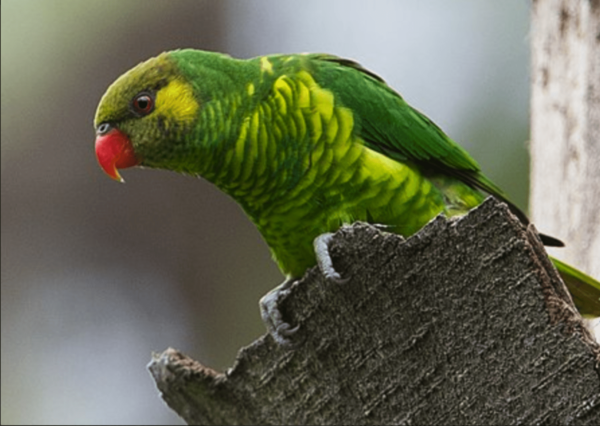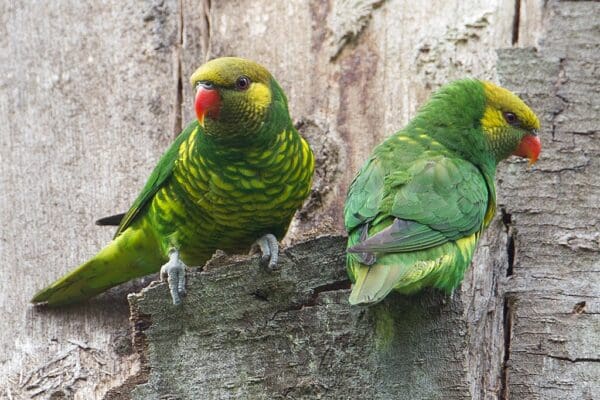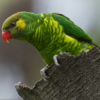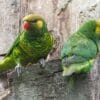Mustard-capped Lorikeet
Also known as:
Meyer's Lorikeet, Yellow-cheeked Lorikeet
Also known as:
Meyer's Lorikeet, Yellow-cheeked Lorikeet

Trichoglossus

meyeri
Size:
20 cm (7.8 in)
Weight:
40-50 g (1.4-1.75 oz)
Subspecies including nominate:
one
Colour Adult:
Both adults upperparts dark green and less scalloped; green/brown hindcrown, occiput and nape; yellow cheeks and throat, widely barred with dusty green; yellow ear coverts. Lores and eye ring bare and grey.
Colour Juvenile:
As in adults, but lores and eye ring paler.
Call:
Calls made in flight are high-pitched and screechy. While feeding in flocks birds give series of moderately pitched, slurred squeaky chattering notes with upward inflection. Also emits high-pitched whistles.
More Information:
Content Sources:
BirdLife International
Cornell Lab of Ornithology/Birds of the World
Captive Status:
Was fairly common in the 1990s.
Longevity:
Up to 25 yrs.
Housing:
Enclosure with well drained, concrete or tiled floor, or indoor aviary, minimum length 1.8 m (6 ft) within a tiled room for ease of cleaning.
Diet:
Nectar such as a commercial type or homemade from: lactose-free baby cereal, honey and malt extract or molasses, mixed with filtered water and made fresh once or twice daily, and comprising at least 40 percent of the diet; fruits such as: apple, pear, orange, bananas, cactus fruits, pomegranate; vegetables such as: carrot, celery, corn on the cob or unsalted tinned sweet corn; green leaves such as: Swiss chard, lettuce, dandelion, sowthistle, chickweed; dried figs soaked in water for a few hours; spray millet; small amount of soaked or sprouted sunflower seed and small amount of canary seed and/or oats.
Enrichment:
Provide bird-safe, unsprayed flowering branches, different sized perches, foraging/puzzle toys, easy-to-clean ladders, noise makers and swings. Also provide overhead misters or shallow water bowls for bathing.
Nest Box Size:
Hinged lid nestbox or L-shaped nestbox, at least 10″ x 10″ x 25″ (25.4 cm x 25.4 cm x 63.5 cm).
Clutch Size:
2
Fledging Age:
7-8 weeks
Hatch Weight:
—
Peak Weight:
—
Weaning Weight:
—
World Population:
Unknown, decreasing.
IUCN Red List Status:
Least Concern
CITES Listing:
Appendix II
Threat Summary:
Not globally threatened. A BirdLife “restricted-range” species. Locally common and known from protected areas Gunung Ambang Nature Reserve, North Sulawesi, and Lore Lindu. Is considered to have a medium dependency on forest habitat, and tree cover is estimated to have declined by 4.8% within its mapped range over the past three generations. Therefore it is tentatively suspected that this may have led to a 1-19% decline in the species’ population over the same period.
Range:
Sulawesi, Indonesia.
Habitat:
Found up 800-2000 m (2624-6560 ft) from lowland to upper montane rainforest; also has been seen in open country where Erythrina sp. is flowering, along forest edge and in isolated stands of trees.
Wild Diet:
Blossoms of Erythrina, Euphorbia and Trema orientalis have been reported.
Ecology and Behaviour:
Seen usually in small groups, noisily mixing with Ornate Lorkeets while foraging. Is shy, keeping to dense foliage where it is nearly impossible to detect.
Clutch and Egg Size:
2 eggs
Breeding Season:
July and possibly November. Nest is in high, mossy tree cavity.
Related Links:
—



